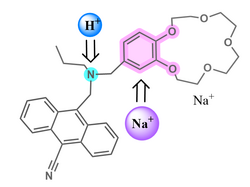Molecular machine
A molecular machine,[1] or nanomachine, is any set of molecules which produce mechanical movements (output) in response to specific stimuli (input).[2][3] The term is common in nanotechnology where a number of complex molecular machines have been proposed which might be a way of making a "molecular assembler". Molecular machines can be divided into two broad categories: synthetic and biological.
The 2016 Nobel Prize in Chemistry was awarded to Jean-Pierre Sauvage, Fraser Stoddart and Ben Feringa for the design and synthesis of molecular machines.[4][5]
Biological nanomachines
The most complex molecular machines are made of proteins, and found in cells. These include 'motor proteins'. Examples are: myosin, (which does muscle contraction), kinesin (which moves molecules from the nucleus along microtubules), and dynein (which produces the beating of motile cilia and flagella). These proteins are far more complex than any molecular machines that have yet been made by mankind.
Probably the most significant biological machine known is the ribosome. Other important examples include motile cilia: "In effect, the [motile cilium] is a nanomachine [of] over 600 proteins in molecular complexes, many of which also function independently as nanomachines".[2][6]
Molecular Machine Media
Kinesin walking on a microtubule is a molecular biological machine using protein domain dynamics on nanoscales. Such motions can now be seen by neutron spin echo spectroscopy
The first example of an artificial molecular machine (a switchable molecular shuttle). The positively charged ring (blue) is initially positioned over the benzidine unit (green), but shifts to the biphenol unit (red) when the benzidine gets protonated (purple) as a result of electrochemical oxidation or lowering of the pH.
References
- ↑ Rincon, Paul. BBC News Science & Environment. Robot surgeons and artificial life: the promise of tiny machines. [1]
- ↑ 2.0 2.1 Satir, Peter & Christensen, Søren T. 2008 (2008). "Structure and function of mammalian cilia". Histochemistry and Cell Biology. 129 (6): 688. doi:10.1007/s00418-008-0416-9. PMC 2386530. PMID 18365235. 1432-119X. Archived from the original on 2020-04-28. Retrieved 2009-09-11.
{{cite journal}}: CS1 maint: multiple names: authors list (link) - ↑ Ballardini R et al. 2001 (2001). "Artificial molecular-level machines: which energy to make them work?". Acc. Chem. Res. 34 (6): 445–455. doi:10.1021/ar000170g. PMID 11412081. Archived from the original on 2020-03-15. Retrieved 2017-01-20.
{{cite journal}}: CS1 maint: uses authors parameter (link) - ↑ Staff 2016. "The Nobel Prize in Chemistry 2016". Nobel Foundation. http://www.nobelprize.org/nobel_prizes/chemistry/laureates/2016/press.html. Retrieved 5 October 2016.
- ↑ Chang, Kenneth & Chan, Sewell (5 October 2016). "3 makers of 'world's smallest machines' awarded Nobel Prize in Chemistry". New York Times. https://www.nytimes.com/2016/10/06/science/nobel-prize-chemistry.html. Retrieved 5 October 2016.
- ↑ Bu Z. & Callaway D.J. 2011 (2011). "Proteins MOVE! Protein dynamics and long-range allostery in cell signaling". Advances in Protein Chemistry and Structural Biology. 83: 163–221. doi:10.1016/B978-0-12-381262-9.00005-7. ISBN 9780123812629. PMID 21570668.
{{cite journal}}: CS1 maint: uses authors parameter (link)









